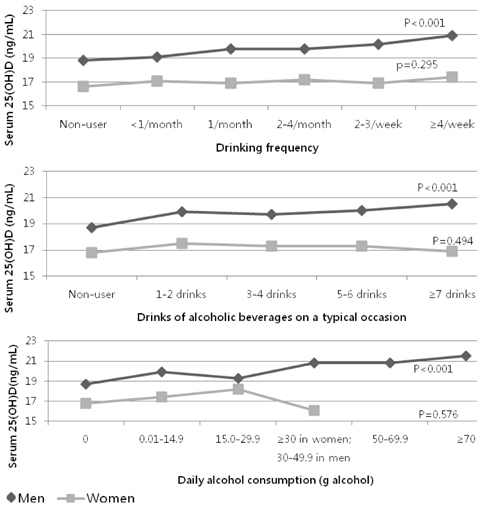Nutr Res Pract.
2012 Feb;6(1):86-90.
Sex-specific relationships between alcohol consumption and vitamin D levels: The Korea National Health and Nutrition Examination Survey 2009
- Affiliations
-
- 1Department of Family Medicine, Busan Paik Hospital, 633-165 Kaegum-dong. Busan jin-gu, Busan 614-735, Korea. kayoung.fmlky@gmail.com
Abstract
- This study assessed the association between vitamin D sufficiency (serum 25(OH)D > or =30 ng/mL) and alcohol consumption using data from the Korea National Health and Nutrition Examination Survey conducted in 2009. The following characteristics were obtained in 7,010 Korean participants > or =19-years-of-age: serum 25(OH)D level, alcohol consumption (drinking frequency, drinking number of alcoholic beverages on a typical occasion, average daily-alcohol intake), and potential confounders (age, residence, housing status, occupation, total fat and lean mass, smoking, physical activity, history of liver diseases, liver function, and daily intake of energy, protein, and calcium). After adjusting for confounders, vitamin D sufficiency in men was significantly associated with drinking frequency, number of alcoholic drinks consumed, and average daily alcohol intake; odds ratio of 1.21-1.72, 2.17-3.04, and 2.27-3.09, respectively. Increase in the three alcohol drinking-related behaviors was also linearly associated with increase in serum 25(OH)D level in men. By comparison, there was no significant association between alcohol intake and serum 25(OH)D level in women. The positive association between vitamin D sufficiency and alcohol consumption was evident only in Korean men.
Keyword
MeSH Terms
Figure
Reference
-
1. Turner RT. Skeletal response to alcohol. Alcohol Clin Exp Res. 2000. 24:1693–1701.
Article2. Laitinen K, Välimäki M, Lamberg-Allardt C, Kivisaari L, Lalla M, Kärkkäinen M, Ylikahri R. Deranged vitamin D metabolism but normal bone mineral density in Finnish noncirrhotic male alcoholics. Alcohol Clin Exp Res. 1990. 14:551–556.
Article3. Turner RT, Aloia RC, Segel LD, Hannon KS, Bell NH. Chronic alcohol treatment results in disturbed vitamin D metabolism and skeletal abnormalities in rats. Alcohol Clin Exp Res. 1988. 12:159–162.
Article4. Gascon-Barré M. Interrelationships between vitamin D3 and 25-hydroxyvitamin D3 during chronic ethanol administration in the rat. Metabolism. 1982. 31:67–72.
Article5. Jacques PF, Felson DT, Tucker KL, Mahnken B, Wilson PW, Rosenberg IH, Rush D. Plasma 25-hydroxyvitamin D and its determinants in an elderly population sample. Am J Clin Nutr. 1997. 66:929–936.
Article6. Egan KM, Signorello LB, Munro HM, Hargreaves MK, Hollis BW, Blot WJ. Vitamin D insufficiency among African-Americans in the southeastern United States: implications for cancer disparities (United States). Cancer Causes Control. 2008. 19:527–535.
Article7. McCullough ML, Weinstein SJ, Freedman DM, Helzlsouer K, Flanders WD, Koenig K, Kolonel L, Laden F, Le Marchand L, Purdue M, Snyder K, Stevens VL, Stolzenberg-Solomon R, Virtamo J, Yang G, Yu K, Zheng W, Albanes D, Ashby J, Bertrand K, Cai H, Chen Y, Gallicchio L, Giovannucci E, Jacobs EJ, Hankinson SE, Hartge P, Hartmuller V, Harvey C, Hayes RB, Horst RL, Shu XO. Correlates of circulating 25-hydroxyvitamin D: Cohort Consortium Vitamin D Pooling Project of Rarer Cancers. Am J Epidemiol. 2010. 172:21–35.
Article8. Choi HS, Oh HJ, Choi H, Choi WH, Kim JG, Kim KM, Kim KJ, Rhee Y, Lim SK. Vitamin D insufficiency in Korea--a greater threat to younger generation: the Korea National Health and Nutrition Examination Survey (KNHANES) 2008. J Clin Endocrinol Metab. 2011. 96:643–651.
Article9. Holick MF. Vitamin D status: measurement, interpretation, and clinical application. Ann Epidemiol. 2009. 19:73–78.
Article10. Yoon YS, Oh SW, Baik HW, Park HS, Kim WY. Alcohol consumption and the metabolic syndrome in Korean adults: the 1998 Korean National Health and Nutrition Examination Survey. Am J Clin Nutr. 2004. 80:217–224.
Article11. Laitinen K, Välimäki M. Alcohol and bone. Calcif Tissue Int. 1991. 49:Suppl. S70–S73.
Article12. Sampson HW. Alcohol, osteoporosis, and bone regulating hormones. Alcohol Clin Exp Res. 1997. 21:400–403.
Article13. Jugdaohsingh R, O'Connell MA, Sripanyakorn S, Powell JJ. Moderate alcohol consumption and increased bone mineral density: potential ethanol and non-ethanol mechanisms. Proc Nutr Soc. 2006. 65:291–310.
Article14. Millen AE, Bodnar LM. Vitamin D assessment in population-based studies: a review of the issues. Am J Clin Nutr. 2008. 87:1102S–1105S.
Article
- Full Text Links
- Actions
-
Cited
- CITED
-
- Close
- Share
- Similar articles
-
- The Mediating Role of Smoking and Body Mass Index on the Relationship between Alcohol Consumption and Blood Triglyceride Levels among Korean Adults: The 7th Korean National Health and Nutrition Examination Survey
- Moderate Alcohol Consumption Does Not Prevent the Hypertension among Korean: the 2001 Korean National Health and Nutrition Examination Survey
- The Relationships of Health-Related Lifestyles with Homocysteine, Folate, and Vitamin B/sub 12/ Status in Korean Adults
- The Relationship Between Lower Vitamin D Levels and Hearing Loss in Older Adults
- Association between Amount of Alcohol Consumption and Serum Fasting Glucose Level in Korean Male in their 40s and 50s: The Seventh Korea National Health and Nutrition Examination Survey 2016–2018


